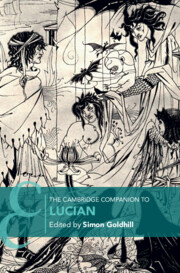Book contents
- Frontmatter
- Contents
- List of Figures and Tables
- List of Contributors
- 1 Introduction
- Part I
- Part II
- 8 In Praise of the Fly
- 9 Lucian’s Phalaris
- 10 Lucian the Doorkeeper: Inside and Outside in Lucianic Poetics
- 11 Geographical Authority and Bodily Entanglement in Lucian’s True Histories
- 12 Menippus Goes to the Moon: Fantastical Astronomy and Lucian’s Scientific Imagination
- 13 Lucian and Christianity
- 14 Identification and Distance in Lucian’s Dialogues of the Courtesans: Subjects and Their Absences
- 15 ‘Here’s Looking at You … ’: The Dialogues of the Gods and the Erotics of the Visual
- Part III
- References
- Index Locorum
- Subject Index
- Cambridge Companions to Literature
14 - Identification and Distance in Lucian’s Dialogues of the Courtesans: Subjects and Their Absences
from Part II
Published online by Cambridge University Press: 07 November 2024
- Frontmatter
- Contents
- List of Figures and Tables
- List of Contributors
- 1 Introduction
- Part I
- Part II
- 8 In Praise of the Fly
- 9 Lucian’s Phalaris
- 10 Lucian the Doorkeeper: Inside and Outside in Lucianic Poetics
- 11 Geographical Authority and Bodily Entanglement in Lucian’s True Histories
- 12 Menippus Goes to the Moon: Fantastical Astronomy and Lucian’s Scientific Imagination
- 13 Lucian and Christianity
- 14 Identification and Distance in Lucian’s Dialogues of the Courtesans: Subjects and Their Absences
- 15 ‘Here’s Looking at You … ’: The Dialogues of the Gods and the Erotics of the Visual
- Part III
- References
- Index Locorum
- Subject Index
- Cambridge Companions to Literature
Summary
This chapter explores the interplay between identification and distance that Lucian sets up for his readers in relationship to the speaking characters in the Dialogues of the Courtesans. While readers are, at times, invited to identify with the plights of these ‘others’ as partners in restrictive power structures, at other times, the otherness of the courtesans is emphasised through female verbal markers, female-specific cults, and women-only sexuality. Again and again, the subjectivity of the courtesan is offered to the reader, only to be withdrawn from their grasp. And, in fact, in its current form, the collection begins with a soldier and ends with a virgin – the courtesan managing to slip away. Lucian’s play with the courtesan’s subjectivity leaves his readers full of suspicions about intentional misdirection, both by the characters within the stories and by the author Lucian himself.
- Type
- Chapter
- Information
- The Cambridge Companion to Lucian , pp. 297 - 317Publisher: Cambridge University PressPrint publication year: 2024

